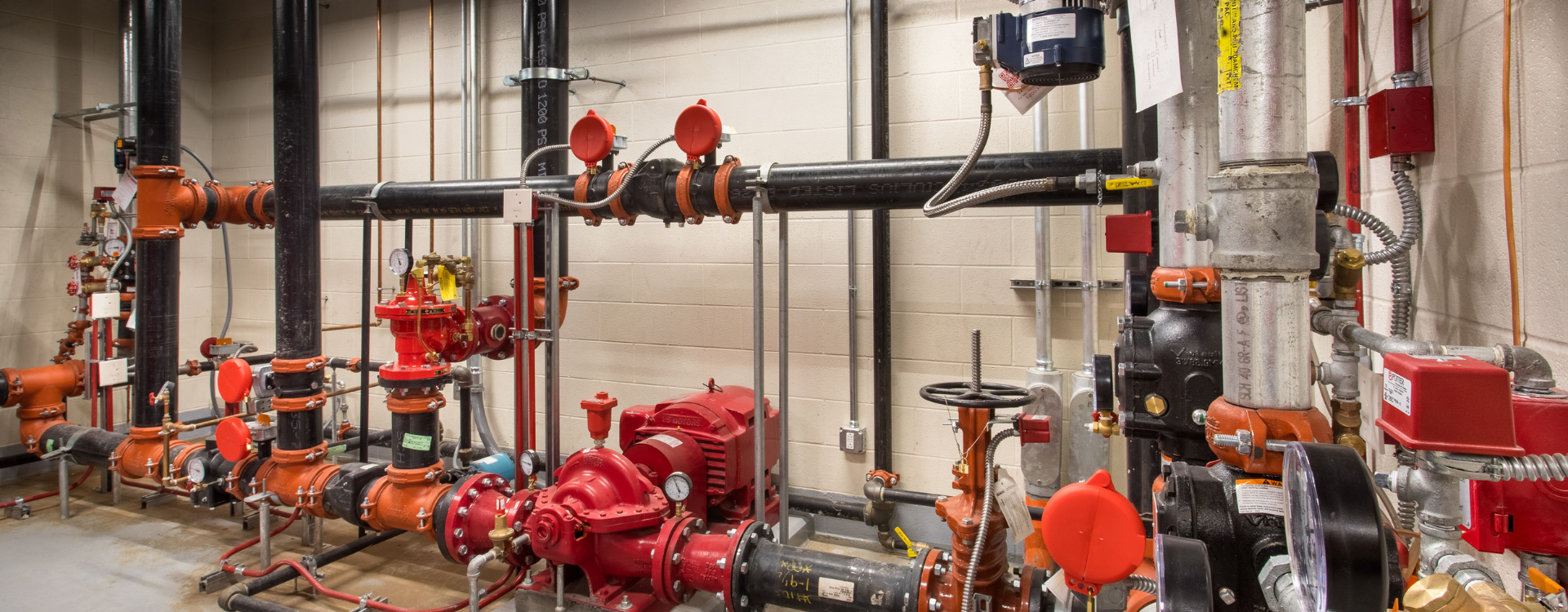
Data center design demands the expertise of a mechanical, electrical, plumbing, and fire protection contractor who understands its numerous challenges, from energy-efficient cooling to evolving battery fire protection requirements. A challenge that is often overlooked is the clustered nature of data center ceilings, specifically in computer room air handler galleries, corridors, and data hall aisles.
Challenges in data center fire suppression
The densely packed ceilings in data centers present unique challenges for fire suppression systems. Components such as mechanical piping, electrical busways, cable trays, and associated structural supports can obstruct sprinkler spray dispersion, increasing the potential of a catastrophic fire.
In data halls, sprinkler protection is commonly found both above and below suspended ceilings. However, the presence of construction elements above and numerous utilities below the suspended ceilings heightens the risk of sprinkler obstructions. The examples below highlight the importance of careful design consideration in data center environments.
Concrete tee construction
National Fire Protection Association 13 Standard for the Installation of Sprinkler Systems and FM Global Property Loss Prevention Data Sheets categorize concrete tee construction as obstructed construction for data centers. Deep tees can create heat pockets that can trap heat and impede the timely activation of sprinkler heads — while even shallow tees pose obstruction risks that necessitate careful analysis. To address these concerns, sprinkler heads are often installed directly under the tees or in every concrete tee bay.

Beneath ceiling obstructions
Obstructions to sprinkler discharge are almost always present beneath the ceilings in data halls. Layered cable trays and multiple runs of busways in cold aisles often require additional structural support, which further complicates matters. Given the size of these components, a thorough obstruction analysis is imperative.
Clustered conduit modeling
On most projects, conduit less than two inches is typically not modeled before installation because individual conduit runs are straightforward. In data halls, clustered conduits present a grouped obstruction to address.
Overcoming data center fire suppression obstructions
Addressing potential obstructions during the design phase rather than attempting adjustments in the field maximizes jobsite efficiency and reduces cost.
Two guidelines from the NFPA 13 can aid in obstruction analysis.
- Guideline for non-structural elements: The three-time rule mandates sprinklers must be positioned from obstructions at least three times the largest dimension of potential obstructions.
- Guideline for structural elements: The beam rule specifies certain distances between sprinkler heads and structural elements. The depth of the structural element below the sprinkler head deflector determines this distance.
An example of proactive design includes anticipating the need for sprinkler heads to utilize flexible hoses on hard piped drops from branch lines above the structure's ceiling. This common design requirement in data halls can lead to complex alterations during installation if not mitigated during the planning phase. Typically, connecting new drops to branch lines onsite would require performing work 10 feet above a suspended ceiling, posing a potential for safety risks and increased work hours for the field team.
Leveraging 3D modeling for obstruction prevention
Potential obstructions are easier to see in today's 3D modeling environment. However, the effectiveness of the design in preventing obstructions depends on the accuracy of the multi-trade models. To ensure success, attention to detail is vital.
In mission critical design, engineers typically have structural and fabrication steel models. Design coordination efforts must emphasize using accurate models to depict actual installation instead of intent.
Planning for data center fire suppression obstructions
Planning for obstructions in clustered areas and reducing sprinkler spacing can enhance the field's flexibility to adjust without exceeding NFPA spacing requirements. Additionally, incorporating adjustable drops for sprinkler heads near supplemental steel can be helpful.
Overcoming fire suppression challenges in clustered data center ceilings requires meticulous planning, adherence to standards, multi-trade coordination, and proactive analysis during the design phase. By addressing potential obstructions early on, data center clients can ensure the effectiveness and reliability of their fire suppression systems, enhancing overall safety and minimizing risks.
Associate Principal Engineer
As Associate Principal Engineer, Anthony works on design-build and design-assist projects in healthcare, education, biotechnology, mission critical, commercial, and entertainment markets. He works hand-in-hand with our model coordinators, estimators, and trade staff through all aspects of a project to create a practical, efficient, and cost-effective design.




